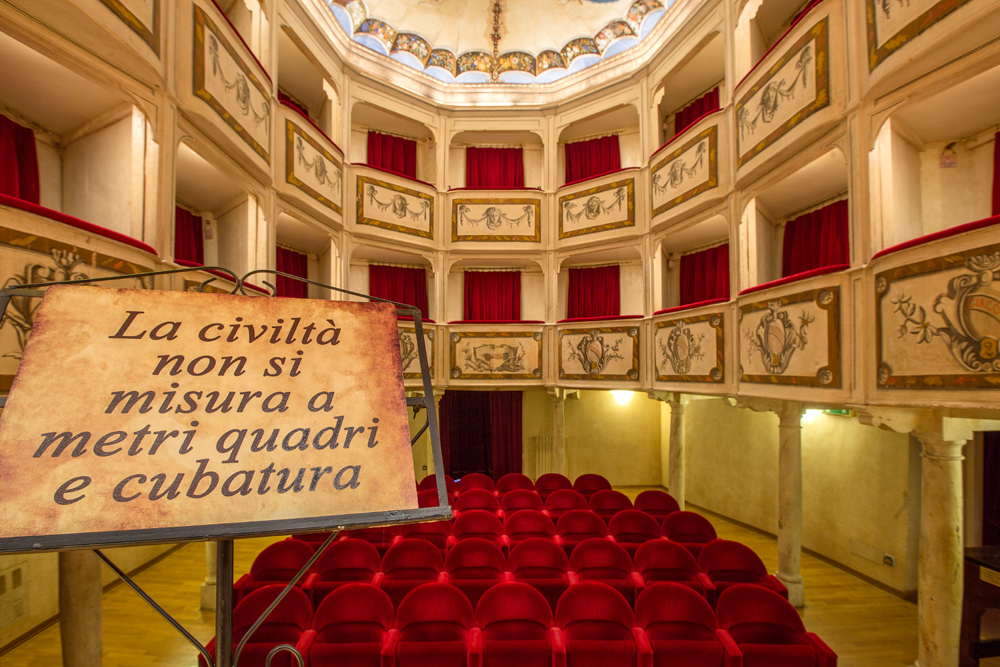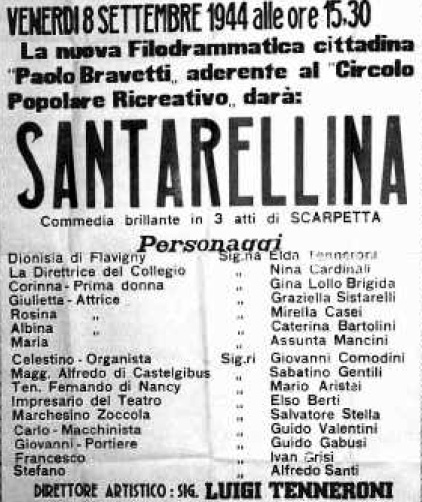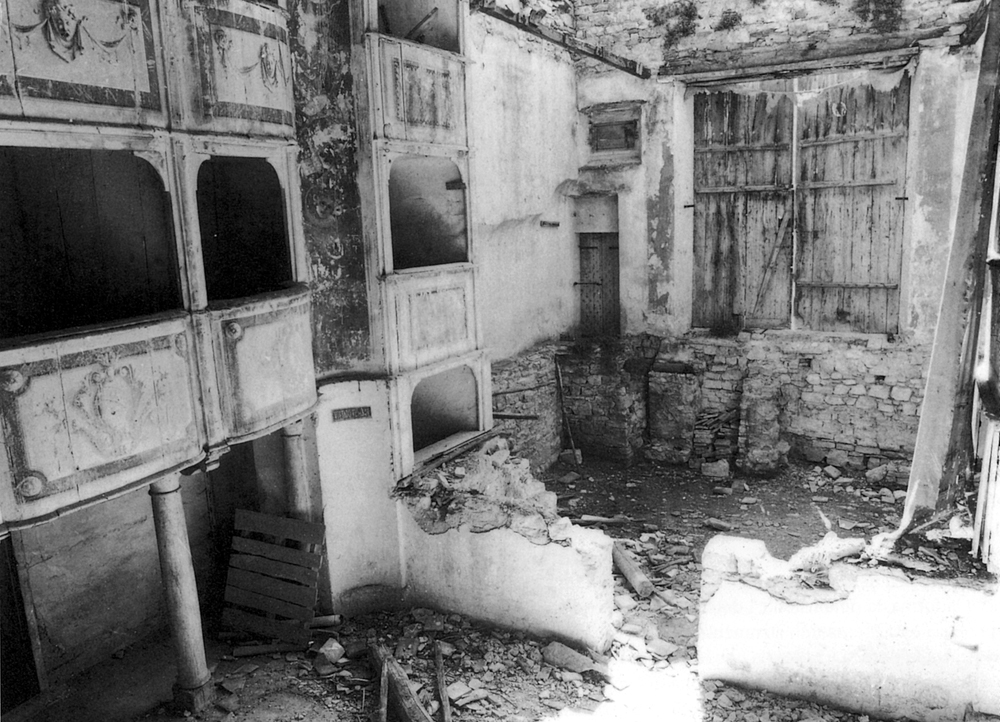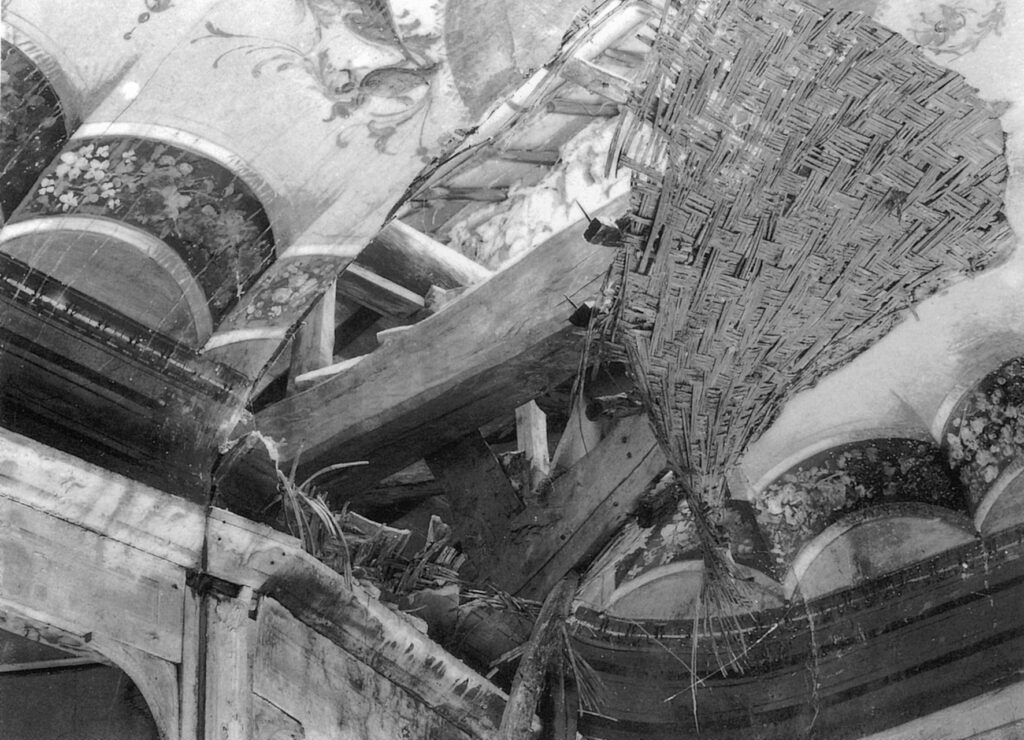Il teatro più piccolo del mondo.
The Teatro della Concordia of Monte Castello di Vibio (Pg) is the smallest Italian style theater And it is one of the smallest historic theaters as it is the only architectural testimony of the 18th-century Italian-style Goldonian miniature theater. It indeed possesses the three fundamental elements that Goldoni advocated for in the construction of theaters: wooden boxes, a bell-shaped floor plan, and a ceiling constructed using the technique of camorcannaIn this sense, as the nine families who wanted to build it wrote, 'civilization is not measured in square meters and volume

The theater was built in thebeginning of the 19th centuryDuring the period of Napoleonic occupation, at the behest of nine local wealthy families as a place of entertainment and gatherings (there was also a coffeehouse-salon). Its inauguration is dated 1808, during a period of cultural peak, almost as if the people of Montecastello wanted to redeem themselves from centuries of vicissitudes and dominations suffered under the nearby Todi. With the word "Concordia," the founders wished to evoke the ideals of French Revolution :liberty, equality, and fraternity. In 1823, the owners of the theater founded the Academy of the Members of the Theater of Concordia, a society established for the management of the theater itself.
"They built it small, according to their own needs and those of their country, but civilization is not measured in square meters and volume"
9 founding families
It was later frescoed in 1892 by the young painter Luigi Agretti, just fourteen years old, who was vacationing in Monte Castello, originally from La Spezia, but the son of Cesare, a Perugian, who had already been the author of the decorations, the curtain, and the backdrops of the Theater of Concordia. Here, the young Agretti released his first artistic expressions. This “giovine venuto dal mar Tirreno” (as a poem written in the same year 1892 by the Montecastello resident Pellegrini recites), he left the impressions of his early vitality in the vibrant colors of his paintings, also contributing to mark this place, through the dedication to the town: Hi, delightful hill, our homeland, like an oasis of tranquility.

After this type of use, there was a period of pause, and it was only in 1919 that the people of Montecastello returned to the stage, coinciding with the appointment of the new parish priest, Don Oscar Marri, a lover of singing and a baritone singer himself. He, along with his cousin Dora Marri, a light soprano, and Candida and Chiara Fabrizi, staged several operettas until 1921. Other performances were also organized until 1926, the year in which a puppet show and operettas were hosted. Even the Royal Army troops made an appearance when, in August 1931, the theater premises were rented for summer exercises. In 1941, during the war, the newly reconstituted local dramatic society staged, among other thing, “L’eredità di zio Bonanima”, the drama “L’amore più forte” (1943), written by the Montecastello resident Filippo Salvatelli, the comedy “La nemica” di Darlo Niccodemi and the bright revue titled “II giro del mondo in 24 ore”, written by Renato Ippoliti (1944). During the same period, it appears that the theater was also graced by who not yet famous but endowed with all her vocal gifts, Subsequently, in 1945, the Theater of Concordia in Monte Castello di Vibio witnessed the first steps of another great celebrity: the very young Gina Lollobrigida, who was in Todi at the time. Here in Monte Castello, she acted in “Santarellina” of Scarpetta, a comedy staged by the director and stage manager L. Tenneroni. On April 8, 1951, a theater event was held “La passione di Nostro Signore” directed by Renato Ippoliti, with significant success, thanks to the enthusiastic participation of the residents.

In 1951, the theater was closed due to its structural unsuitability. In the second half of the 1970s, in 1976, after a further partial collapse of the roof and part of the audience area, Mayor Vittorio Antonini conducted an inspection of the facility and realized the dire conditions in which the theater was situated. He decided to take urgent action to salvage what could be saved. However, the town's coffers were empty at the time, so the only decision that could be made was to dip into personal finances. It was Mayor Antonini who introduced the idea and initiated a public subscription, through which an intervention was carried out on the roof to protect and salvage what remained of the building, furnishings, and decorations.
Fortunately, the desire to save the theater prevailed among the citizens, and thanks to the operational contributions of some local small construction companies, the first recovery intervention was made possible. This intervention practically prevented the imminent and definitive ruin of the structure.

In 1981, the municipality of Monte Castello di Vibio initiated the expropriation process, thus enabling the restoration project with funding from the European Community. It wasn't until 1993, after seven years of work (under the direction of architects Paolo Leonelli and Mario Struzzi), that the restoration work was completed, preserving the original wooden structure supporting the balconies. In fact, during load tests, it proved to fully meet the required standards. This allowed for the recovery of a valuable architectural heritage with the utmost respect for the original frescoes.

In July 1993, the Society of Teatro della Concordia was established with the aim of managing the theater's activities. The goal we set is to turn it into the Weekend Theater. A mandatory tourist and cultural stop for those who visit Umbria. Monte Castello di Vibio is the ideal village, with ancient memories, a lost paradise where you can rediscover the right pace of life. Here, you can spend an evening in the world's smallest theater, enjoy dinner with the flavors of traditional Umbrian cuisine, including overnight stay and, the next day after breakfast, head out to visit a location in Umbria before returning to the stressful city life. The programming ranges from drama to opera, operettas, classical music concerts, and jazz. The Theater of Concordia is also used for meeting and conferences, besides being already requested for the celebration of civil weddings.
It is also a destination for tourists, since its reopening in 1993, over 150,000 visitors have crossed its threshold, bestowing the diploma of EXCELLENCE through the tourist portal Tripadvisor.

Fondazione Società del Teatro della Concordia ETS
Ente del Terzo Settore con Personalità Giuridica – Iscritto al R.U.N.T.S. repertorio 50364
Piazza del Teatro della Concordia, 4 – 06057 Monte Castello di Vibio (PG)
c.f. 94047230548 – p.iva 02244990541
© Copyright 2024
| Cookie | Durata | Descrizione |
|---|---|---|
| cookielawinfo-checbox-analytics | 11 months | This cookie is set by GDPR Cookie Consent plugin. The cookie is used to store the user consent for the cookies in the category "Analytics". |
| cookielawinfo-checbox-functional | 11 months | The cookie is set by GDPR cookie consent to record the user consent for the cookies in the category "Functional". |
| cookielawinfo-checbox-others | 11 months | This cookie is set by GDPR Cookie Consent plugin. The cookie is used to store the user consent for the cookies in the category "Other. |
| cookielawinfo-checkbox-advertisement | 1 year | Set by the GDPR Cookie Consent plugin, this cookie is used to record the user consent for the cookies in the "Advertisement" category . |
| cookielawinfo-checkbox-necessary | 11 months | This cookie is set by GDPR Cookie Consent plugin. The cookies is used to store the user consent for the cookies in the category "Necessary". |
| cookielawinfo-checkbox-performance | 11 months | This cookie is set by GDPR Cookie Consent plugin. The cookie is used to store the user consent for the cookies in the category "Performance". |
| CookieLawInfoConsent | 1 year | Records the default button state of the corresponding category & the status of CCPA. It works only in coordination with the primary cookie. |
| elementor | never | This cookie is used by the website's WordPress theme. It allows the website owner to implement or change the website's content in real-time. |
| ts | 3 years | PayPal sets this cookie to enable secure transactions through PayPal. |
| ts_c | 3 years | PayPal sets this cookie to make safe payments through PayPal. |
| viewed_cookie_policy | 11 months | The cookie is set by the GDPR Cookie Consent plugin and is used to store whether or not user has consented to the use of cookies. It does not store any personal data. |
| Cookie | Durata | Descrizione |
|---|---|---|
| x-cdn | session | Paypal sets this cookie to recognise customers and process payments. |
| Cookie | Durata | Descrizione |
|---|---|---|
| _ga | 2 years | The _ga cookie, installed by Google Analytics, calculates visitor, session and campaign data and also keeps track of site usage for the site's analytics report. The cookie stores information anonymously and assigns a randomly generated number to recognize unique visitors. |
| _gat_gtag_UA_36448898_1 | 1 minute | Set by Google to distinguish users. |
| _gid | 1 day | Installed by Google Analytics, _gid cookie stores information on how visitors use a website, while also creating an analytics report of the website's performance. Some of the data that are collected include the number of visitors, their source, and the pages they visit anonymously. |
| CONSENT | 2 years | YouTube sets this cookie via embedded youtube-videos and registers anonymous statistical data. |